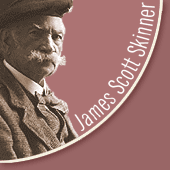




Please click any thumbnail image to view the full details.
There are 900 entries.
1 > 2 > 3 > 4 > 5 > 6 > 7 > 8 > 9 > 10 | next 10 of 90 pages
| Image | Title | Item Description |
|---|---|---|
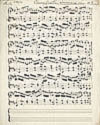 JSS0041 |
Cluny Castle Inverness-shire | Cluny Castle was the home of Macpherson of Cluny. Many thought that the composer, Alexander Troup (b. near Ballater, Aberdeenshire, 1835) was 'one of the greatest living authorities upon all things pertaining to Scotch music.' As a young man he led the psalmody at before Queen Victoria at Crathie Church, by Balmoral Castle. He also performed before her with Willie Blair, The Queen's Fiddler. The tune, a rather stiff strathspey-like air, is in D major, with 'Slowly' written above and left of the music. The form is 4 bars, repeated, then 8 bars, followed by one variation. An error in the third last bar, correct in the printed version, gives two quavers, rather than two semi-quavers. |
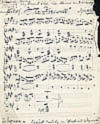 JSS0042 |
My Bonnet Blue lies stained and Bloody, or the Farewell | This is a larger version of JSS0039. The tempo has been changed from 'with intense and patriotic feeling' to 'slowly and unaffectedly'. The same message to the engraver has been included here, which shows that Skinner still intended this to be the final piece in the collection. It is called 'The Composer's Farewell' in the published version. The melody has been slightly altered in bars 3, 7-10, 13-14 and 16, and is very different in bar 6. The rhythm has been changed here and there, as has the harmony. This is closer to the final published version. |
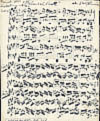 JSS0043 |
Balmoral Castle | Balmoral Castle, in Aberdeenshire, is the Royal Family's Scottish Highland retreat. Prince Albert had it built in 1855 for Queen Victoria on the grounds of the original castle (1546). Skinner describes the music as a 'March bright & teeming with life'. The first of two variations represents 'a rush of water', probably the river Dee as it runs through the castle's grounds. Skinner revised it for the Harp and Claymore in February 1896. |
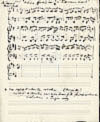 JSS0044 |
Where Gadie Runs or The Hessians March | 'O Gin I were whaur Gadie Rins' is a traditional North-east song. At the top left, 'The Gordons March Past' refers to the Gordon Highlanders regiment, raised in 1794. The alternative title, 'The Hessians' March', is for the music, thought to have been imported into Scotland by Scottish soldiers who had served in Europe. Skinner's unfinished version comes 'From the Late Wm Christies collection (Monquitter),' an Aberdeenshire parish, north of Fyvie. 'Mr Christie's sons were Deans of the Episcopal Churches Fochabers & Enzie -'. Dancing master William Christie's Collection of Strathspeys, Reels, appeared around 1820, while his son, Dean William Christie, published two volumes of traditional ballads (1876, 1881). |
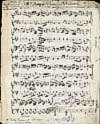 JSS0045 |
St Mungo's Welcome to Scott Skinner | The title of Skinner's "*St Mungo's Welcome to Scott Skinner" has been pasted over another title and inscription. Top left is 'May be played either pathetically or Heroically. the latter - '. At the right top is 'by J Sco_' (obscured by a glued fold of paper) 'at Keith, June 1889'. In the right margin is 'St. Mungo's', parallel to the page edge. At the foot of the page he noted the inspiration for the tune, the '*Celtic Tournament at Glasgow 4 Nov 1889 - ', followed by a purple penciled 'slip', a correction to the melody in the bar above. Beneath the bass line in the first bar, last system, 'Drones' is a reminder that the notes (octaves and fifths) represent the drones of the Highland bagpipe. St Mungo is the patron saint of Glasgow, supposedly buried at Glasgow Cathedral. |
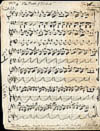 JSS0046 |
The Battle of Falkirk | Skinner's '*"The Battle of Falkirk"; is a 'Quick step', a type of 'couple dance' (for two people). There were two famous 'Battles of Falkirk'. The first, in 1298, between the English and the Scots, was led by 'The Scottish Patriot' William Wallace. In 1746 the Jacobites fought the English there, as they withdrew northwards towards the final battle at Culloden, near Inverness, 12 April 1746. The music is set as for the bagpipes, with the G sharp in the A major key signature (F, C, and G sharp) replaced with a natural sign. This is because the bagpipes lack a true G sharp, and sound a note closer to G natural. The last four systems are Skinner's two violin variations, without piano, since the variations use the same harmony as the original melody. As he wrote at the foot of the page, '* The Variations, need no accompaniment, simply run on like the Logie Coll[ection]s Pipe tunes.' The lower staves, not needed, are crossed out with pencilled scallops. |
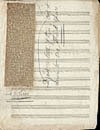 JSS0047 |
Newspaper clipping: SKetch of Pipe-Playing at Highland Gatherings | On the verso of 'St Mungo's Welcome to Scott Skinner' Skinner glued an undated newspaper clipping providing background to the 'Highland Gathering' at the 'Glasgow International Exhibition', in which he had participated. The article, a brief history of piping competitions, mentions Mendelssohn attending one at the Theatre-Royal, Edinburgh, 29 July 1829, and others which had taken place in Lahore, India, and the Crimea. Skinner's notes to the engraver tell him to use 'just a little of this, cut it down to one third space', 'about 25 lines'. In the printed version only the place and date of the event appear, as a footnote: '*Celtic Tournament at Glasgow, 4th Nov. 1889.' |
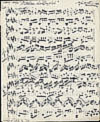 JSS0048 |
Madam de Lenglee | Madam Finart de Lenglée was the daughter of a French General, a recipient of the Legion d'Honneur. She assisted Skinner and his adopted daughter Jeannie Meldrum with his dancing classes during his wife Jean's long illness. The note at the bottom of the page, 'revised Feb: 14 '96', could suggest that Skinner wrote this as a Valentine's Day present for Madam de Lenglée, the widow of his brother Alexander (Sandy) Forbes Skinner (d. 1883). Both Skinner's 'Melody' (to be played 'Unaffectedly'), and two variations, are set in six two-stave systems. Skinner has written out the piano 'left hand' in full, rather than re-use the harmony under the melody, as he often does. The harmonic and rhythmic changes provide more musical contrast, so that the variations stand out boldly. |
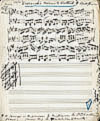 JSS0049 |
Carnegie's Welcome to Scotland | The title of the 'March Met[metronome marking] Tempo 112 & Breezy' is underlined with blue crayon, and signed 'J Scott Skinner'. at the right. He had planned a variation to be set simply with 'no Bass small notes', but later crossed out the instructions. Andrew Carnegie (1835-1919), steel magnate and philanthropist, was briefly the world's richest man. Born in Dunfermline, Scotland, he emigrated to the United States in 1848. He returned to Scotland in 1881, although Skinner's tune may have been written later. Skinner notes that '*Mr Carnegie is the possessor of Macpherson The Freebooters Violin. glorious thing the distribution of wealth'. He continues, along the right page margin, 'The Freebooters 'Claymore' is in Duff House, Banff - The Property of Lord Fife [Lord Braco, the first Earl of Fife]'. James MacPherson, 'The Freebooter' (someone who pillages and plunders), is traditionally supposed to have played the fiddle, and composed his 'Macpherson's Lament' shortly before he was hung for theft in Banff, on the northern coast of Banffshire, in 1700. |
 JSS0050 |
The Lonach Gathering | A piece of paper glued on at the top of the page reads 'March Met[ronome] 112. The Lonach Gathering J. Scott Skinner.' The melody has been written first, in bold black pen-strokes. The added bass line, in simple octaves, is sketched in lightly, with a different pen nib. The Lonach Highland and Friendly Society was founded in 1822, formed to build a cairn to celebrate the coming of age of the son of the local laird, Sir Charles Forbes. The Lonach Gathering, commemorating that event, is held on the fourth Saturday in August in Strathdon, Aberdeenshire. The Men of Lonach parade wearing full Highland dress, carrying pikes and Lochaber axes. They also visit local residents, sometimes accepting a dram, a small glass of Scotch whisky. |
1 > 2 > 3 > 4 > 5 > 6 > 7 > 8 > 9 > 10 | next 10 of 90 pages
